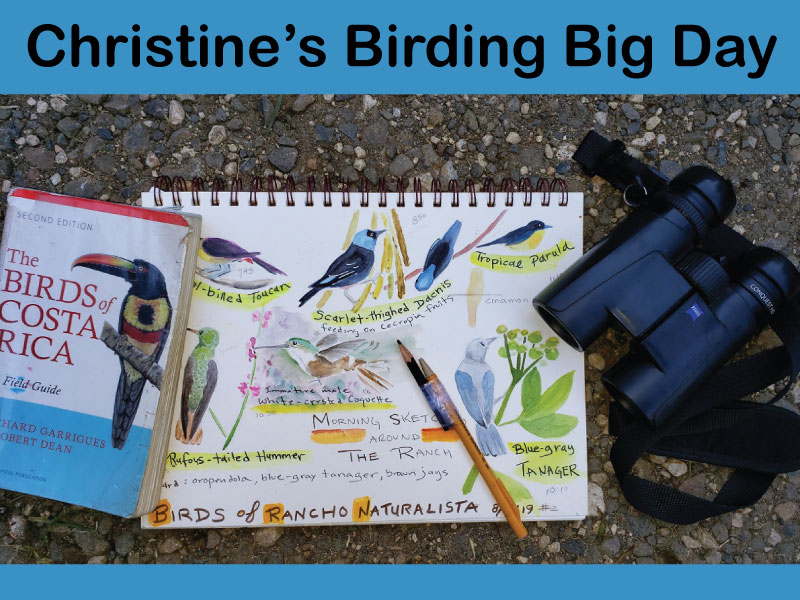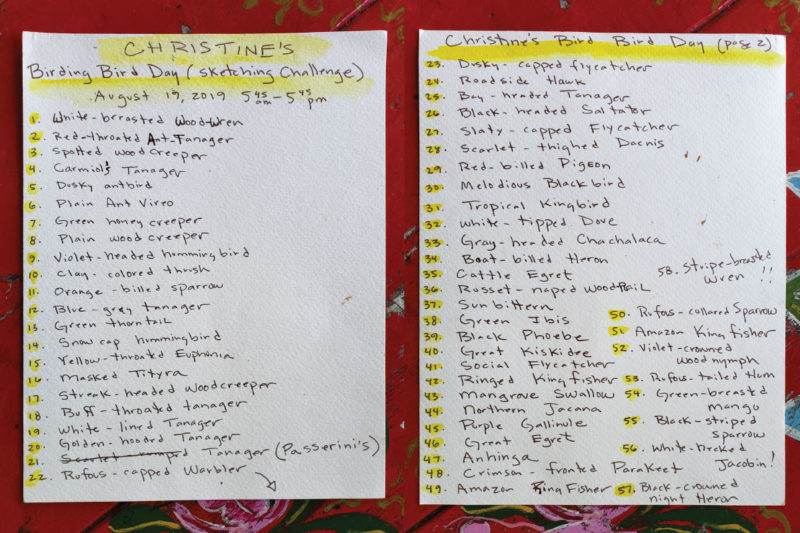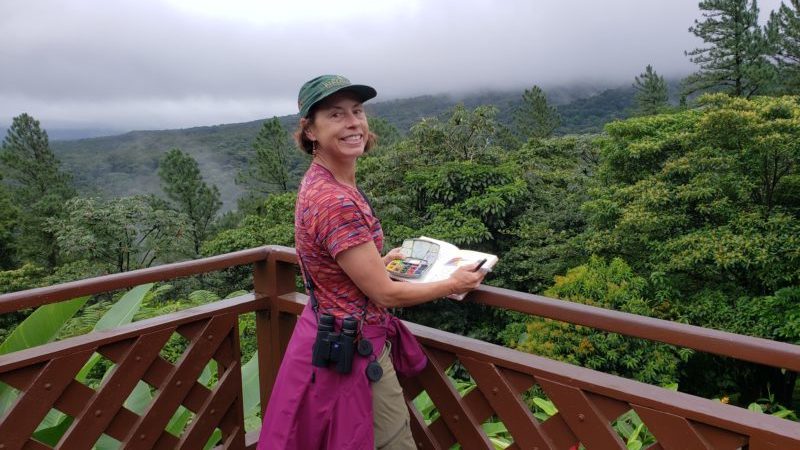Inspiration for My Sketching ‘Big Days’
While spending six weeks birdwatching in Costa Rica, I had time to read in the evenings since the days are short in the tropics. I found a well-worn copy of Birding Without Borders written by fellow Oregonian Noah Strycker on a coffee table. It’s about his record-breaking global ‘big year,’ in which he hoped to see half the world’s bird species. You’ll have to read the book yourself to learn just how many birds he saw, but he was indeed pleased with the final tally.
Noah’s adventures inspired me to accomplish a more modest goal to top off my time spent in Costa Rica. As an artist, naturalist, and birdwatcher I decided to combine these three passions to create my own version of a Big Day. I repeated this activity a year later in Ecuador where I combined participating in the city of Mindo’s Christmas Bird Count with another sketching big day, then again in Belize. Read about both below!
COSTA RICA BIRDING BIG (SKETCHING) DAY
ECUADOR BIRDING BIG (SKETCHING) DAY
BELIZE BIRDING BIG (SKETCHING) DAYS
My Rules for the Days
Each birder sets their own rules for what species ‘count’ on their Big Day list. For example, some folks count all species seen, some also include those that were ‘heard only’, while others only count those species that they had personally found without a guide’s assistance. I decided my rule would be to count only the birds I’d see during one 12-hour period which I had also sketched in the field as I observed them.

A Great Guide is Essential
Since I’m new to birding in Costa Rica, I enlisted the help of an excellent guide; Mercedes (Meche) Alpizar, who intimately knew both the birds and the terrain. I was thrilled to find not only a woman birding guide to help me, but she’s also one of the top birders in the region, having won the ‘Big Year Costa Rica’ in 2017. I also wanted to help support her new nonprofit organization, Ninos y Aves, that is educating local school children on the value of birds in their country.

Mymost excellent birding guide, Meche Alpizar
Reasons for Attempting a Big Day
Everyone has very personal reasons for completing goals such as ‘big years’ and even ‘big days’, and mine was no different. Challenging myself to complete a birding Big Day would hone my bird identification skills and improve my field sketching techniques.
I also hoped that designing and finishing a Big Day would help to focus my brain, which had been in a disheveled state for several months following a sea change in my personal life.
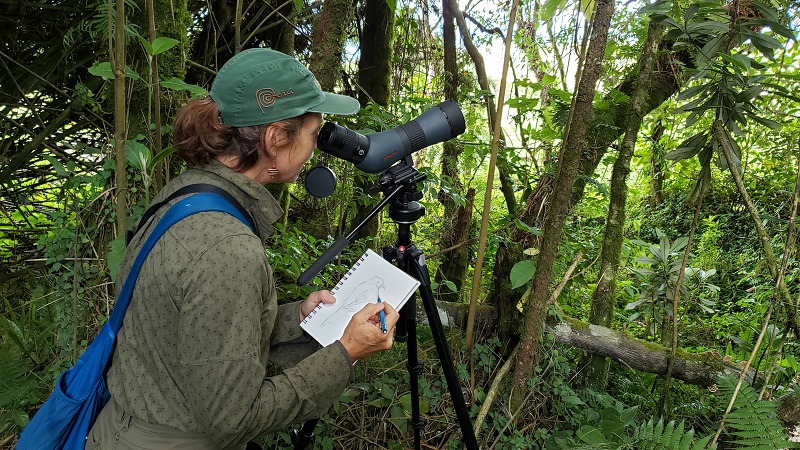
Preparation for the Big Day
I spent a week preparing for my Birding Big Day, getting to know the trails on the grounds of Rancho Naturalista, the birding lodge where I was based. I studied the identifying features of the common bird species I was likely to see. I tried out different sketching tools and techniques. And I practiced packing my supplies so I’d be prepared for whatever the weather might throw at us.
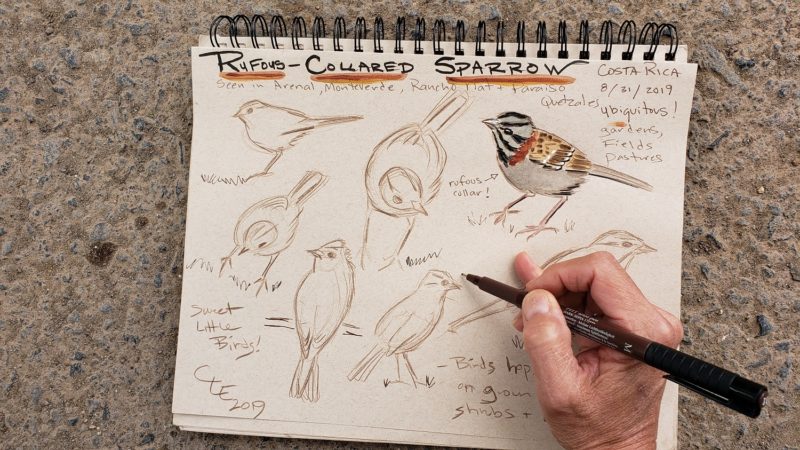
Art Supplies
I prefer to keep my art supplies super simple when I’m out in the field. For this project, I stuck with an even more pared-down version that included a hard-bound watercolor journal, made more sturdy by being attached to a clipboard, a brown Prismacolor Verithin colored pencil, a sharpener, my portable watercolor set and water brush. And of course, my Zeiss Binoculars.
I also carried water, snacks, a rain jacket, and a plastic bag for sitting on wet ground and benches. The bag turned out to be more useful than I’d imagined, for I ended up needing to put my sketchbook inside it when the rain began to drench us! I even finished my sketch of a roosting Cattle Egret with my book in the bag as the rain poured down. I carried everything in my over-the shoulder waterproof Patagonia purse.

Sketching Techniques
In order to sketch as many species as possible, as accurately as possible during my Big Day, I followed a specific method.
Each time I would spot a new species, I would get the bird in my binoculars or my guide’s scope. Since birds don’t tend to stick around long, I might only get one chance to view it and study its identifying features. So, I would simply watch it intently for as long as I had it in my view; noticing things like its size, shape, color patterns, and other ‘field marks’ as birders call them.

I would often verbalize what I was seeing in order to further cement the bird in my mind’s eye. For example, I would say something like “robin-sized bird, black stripes on head, olive-colored wings with yellow shoulder patch, gray body, finch-like bill. It’s a Black-striped Sparrow. Check.”

Only after the bird had flown away, would I begin sketching it from memory. My brown colored pencil didn’t allow for any erasing, which has both pros and cons. I sketched very lightly at first with barely visible lines, then strengthened and darkened the lines as I went. If I’d only gotten a cursory look at a species, such as the Dusky Antbird, then my sketch remained loose. But if I was able to observe the bird longer, or during several separate occasions, like in the case of the roosting Boat-billed Heron, I was able to end up with a much more finished product.
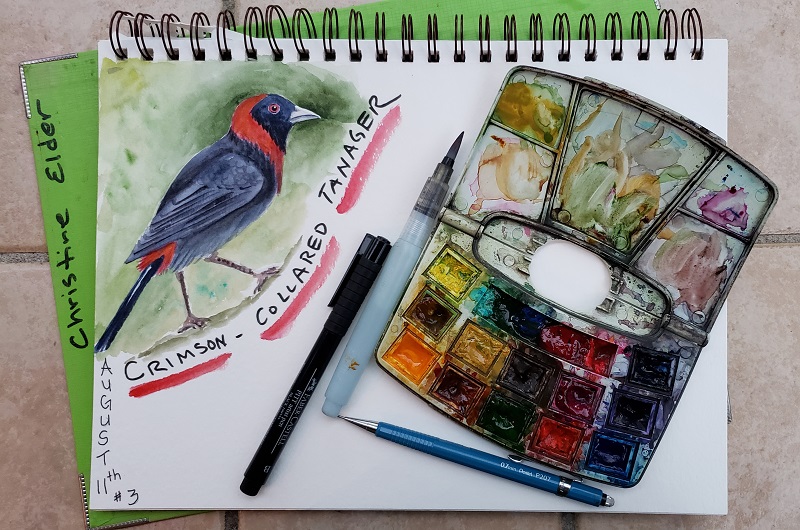
In general, a bird would give me between 10 seconds and 5 minutes to sketch it before it flew. This ‘drawing from memory’ technique admittedly takes some practice and knowledge of bird anatomy, but I’ve gotten better over the years and continue to improve with each sketching session.
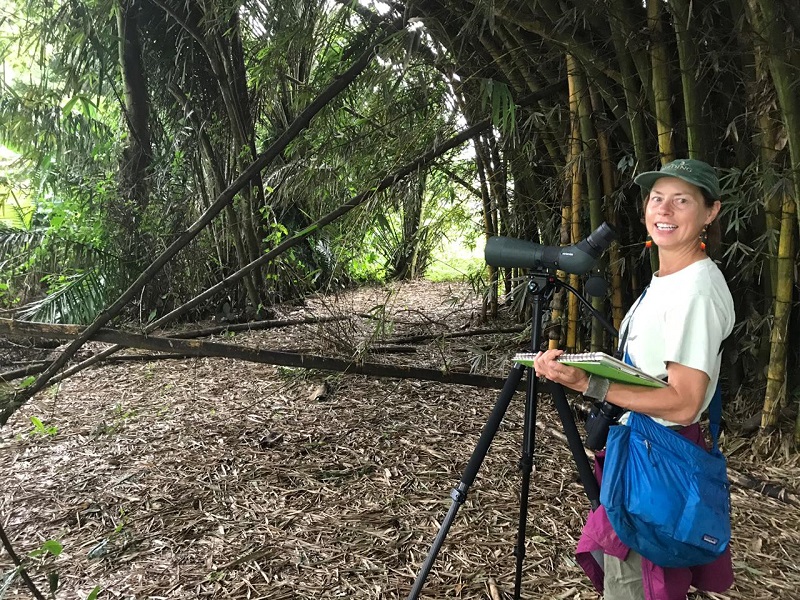
I had hoped to be able to add color to my sketches while in the field as I usually do, but the speed at which we saw new birds overwhelmed me, as did the wet and rainy conditions. Thus, I ended up spending the following day fleshing out my pencil sketches with watercolors, using the color notes I had taken in the field. I referred to field guides as a last resort when my memory wasn’t as sharp as I’d hoped.
The only bird I was able to paint in the field as I watched it was the Red-billed Pigeon, which sat motionless for 5 minutes at the top of a tree.

Locations Visited
We began the day with 6 hours on the grounds of Rancho Naturalista, then two stops made on the road and along several creeks between La Suisa and Turrialba, followed by 2 hours at the botanical gardens and lagoon on the grounds of CATIE; the Tropical Agricultural Research and Higher Education Center in Turrialba.
The day ended back home at the ranch on the balcony where I finished my last drawings of the ever present and hungry hummingbirds at the feeders.
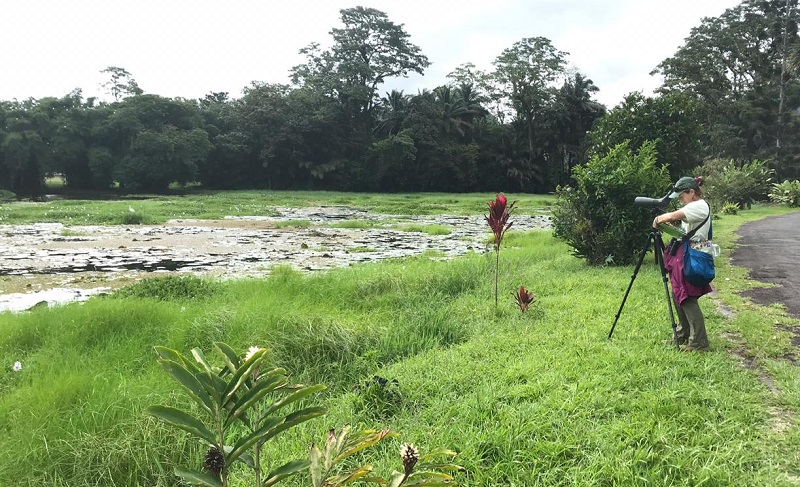
Species Round-up
Lifers seen: While many of the birds in Costa Rica were ‘lifers’ for me, such as the highly sought after Sunbittern, others I had already seen during my stay. I was treated to a few new ones for the ‘big day’ including Carmiol’s Tanager, Dusky Antbird, White-lined Tanager, Mangrove Swallow, Russet-naped Woodrail, and the Stripe-breasted Wren.
Old friends seen: Several birds seen are old friends from the United States, including the Cattle Egret, Great Egret, Great Kiskidee, Black Phoebe, Black-crowned Night Heron, Tropical Kingbird, and Social Flycatcher.

Bittersweet Memories
Others held both fond and bittersweet memories of the first times I saw them, for birders nearly always remember the first time they saw special ‘lifer birds’ and I’m no different. The Green Honeycreeper, Masked Tityra, Boat-billed Heron and White-necked Jacobin all reminded me of previous visits to Central America accompanied by my long-time partner, with whom I’ve since parted ways.
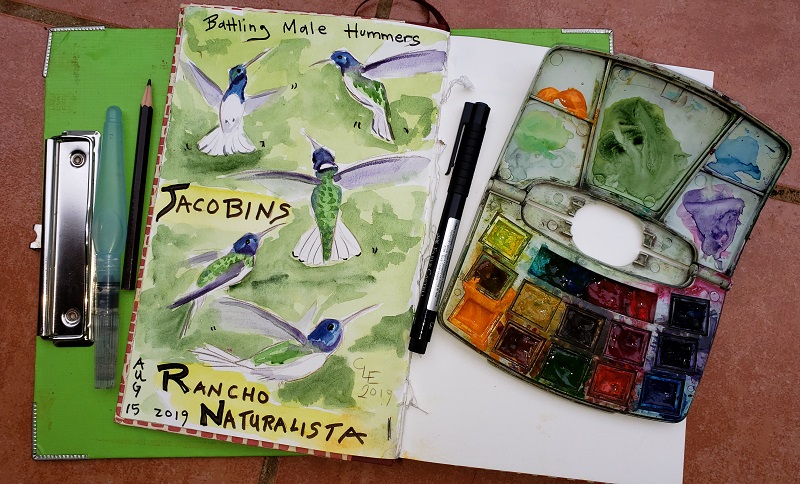
Favorite Birds of the Day
So, you may ask, what were my favorite birds seen and sketched? I’d say the rare but locally abundant Snowcap Hummingbird tops the list with its snow-white head and red wine-colored body, followed closely by other colorful denizens of the tropics like the Golden-hooded Tanager, Passerini’s Tanager, the Ringed Kingfisher, and of course the largest and flashiest of them all, the stream-dwelling Sunbittern.
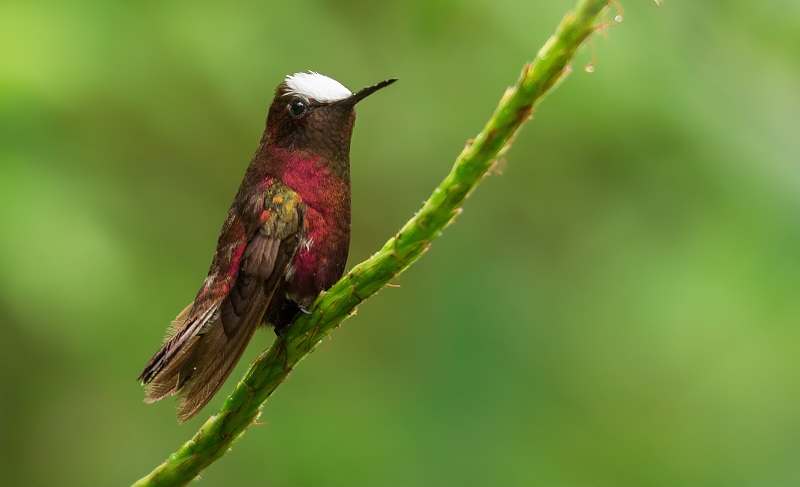
I was disappointed that I couldn’t sketch (thus officially count), the Great Potoo we spied roosting in a tall tree, because we saw it at the end of the day, when the pouring rain had soaked us to the bone and we were just plain worn out!
Curiously, a few birds that I’ve frequently seen during my 3-week stay at Rancho Naturalista, and hoped to include in my Big Day sketches, were absent including the Keel-billed Toucan, Crested Guan, Lesson’s Motmo,t and Collared Aracari. Thankfully, I had already sketched these species on previous days.

Final Statistics
We saw 81 species plus heard an additional 14 species. I filled 15 pages of my sketching journal with 79 individual sketches and enjoyed a final count of 58 species sketched. I also used up one entire brown Verithin colored pencil!
What I’d do differently next time
Knowing what I know now after my Big Day, I would have experimented with a larger variety of materials at home before my trip. Then I would have realized that the Prismacolor Verithin pencil was the best choice and I would have packed more of them. Because, towards the end of my Big Day, my pencil had gotten so short that I had to tape it to another longer pencil in order to finish my sketches!

I also would have sketched every bird I saw, as soon as I saw it, even if I thought I’d surely see it again later in the day. This is how I missed the ubiquitous Brown Jays and Oropendolas in my sketches!
Take Away: Why Do a Big Day?
I encourage you to try challenging yourself to a ‘big day’, whether it’s drawing birds or another subject you fancy. The time, focus, and discipline required will make you a better field sketcher, giving you increased speed and greater confidence in your abilities to capture the beauty of the natural world!

